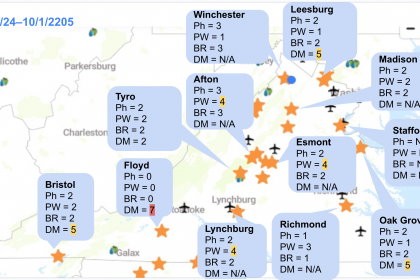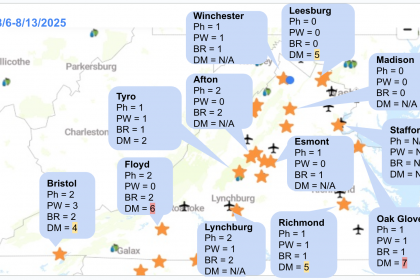I hope you had a nice Fourth of July!
Here’s a snapshot from the last week, showing the number of days with the risk of each disease: Ph = Phomopsis, PW = Powdery mildew, BR = Black rot, and DM = Downy mildew. At this point, Phomopsis risk probably won’t be as important as earlier in the season. I am still listing for my interest, but you can ignore Phomopsis since they are probably done with their spore production. This information was made available through the Wine Board-funded Sentinel Vineyard project.
Looks like central VA had more rains than the rest of the state. The majority of vines are done with the critical period, but make sure to check how long flowering lasted for your vines. Some cultivars are can be at the last stretch of the critical period of cluster infections for downy mildew, powdery mildew, black rot, and Botrytis. If this applies to your vines please protect them. We can relax six weeks after bloom, but until then, please keep your guard up. Also, please make sure that you won’t violate the 66-day PHI of mancozeb products.

The image above is just a summary of the past seven days. These risk events help you understand what happened. However, preparing your sprays to protect your vines would be best. Please visit https://newa.cornell.edu/ to obtain more detailed information. You can check daily weather data and disease and insect pest model results, including forecasted risks. We paid the annual fee so that growers in Virginia could freely access NEWA.
One way to use this information is to adjust your spray intervals. If you see many days with disease risk(s), you may need to shorten your spray interval, or if you missed a material for downy mildew or black rot, you might wish to spray material(s) with kick-back activity. Or you may want to extend your spray interval, if you have not seen many risks as we have been experiencing this year.
It is essential to understand that the spray decision must be based not only on the weather condition but also on the cultivar and history of the disease(s) in your vineyard. Here’s a slide set from the previous virtual viticulture meeting which covers post-bloom disease management.
One last item! If you see an outbreak of black rot despite the spray (especially DMI fungicides such as Rally and tebuconazole, FRAC group 3), please contact either me or Dr. Anton Baudoin who can test for fungicide resistance.





